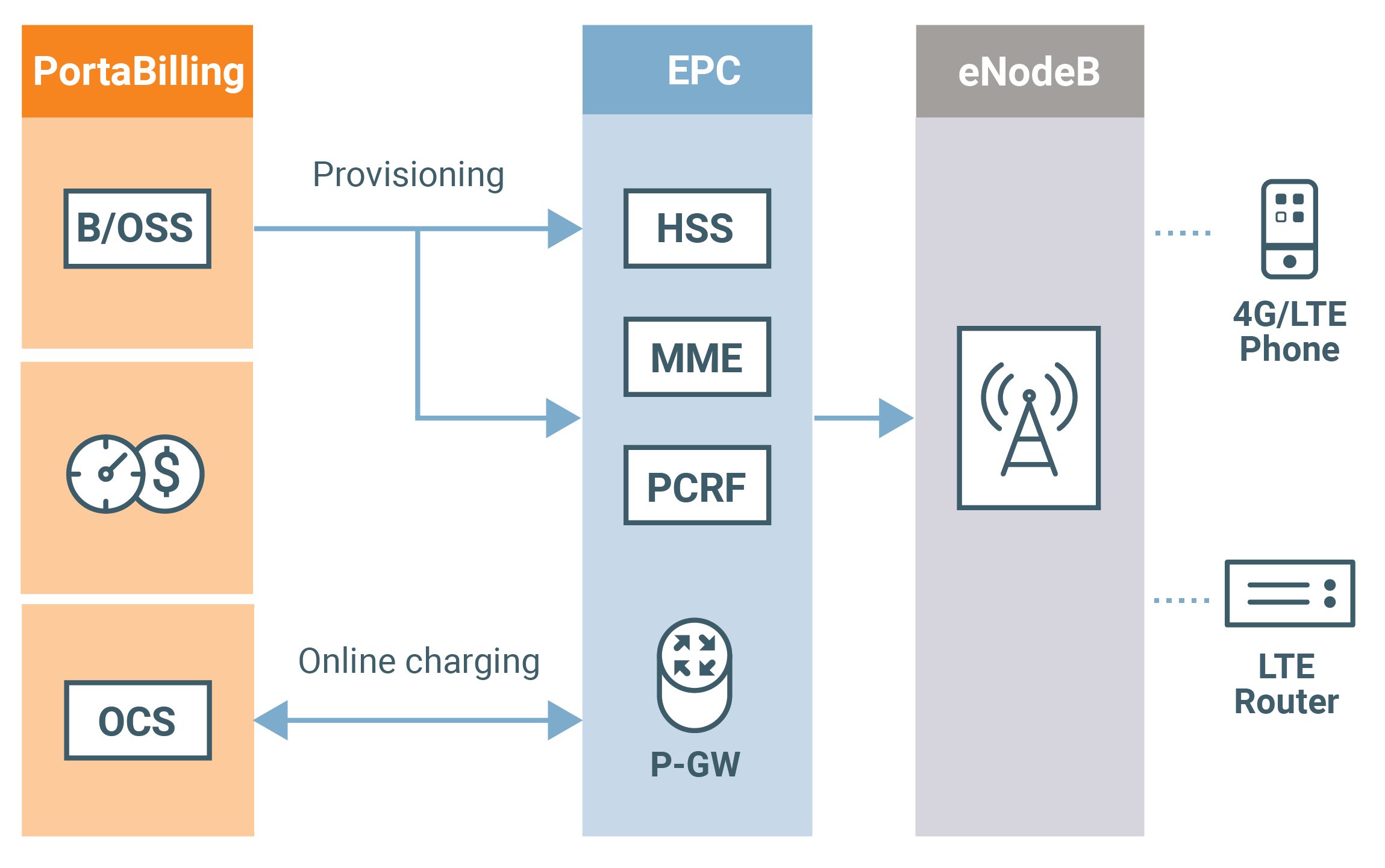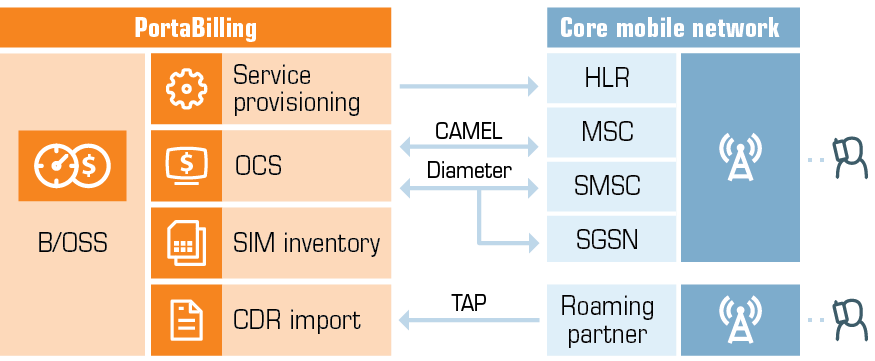For a service provider planning to become a mobile operator, there are two alternative options for entering the mobile market. The first one, and perhaps the most straightforward one, is through acquiring a spectrum license and deploying your own mobile network.
The other market entrance option is to become a virtual mobile network operator (MVNO) and utilize the network infrastructure of an existing MNO (mobile network operator). This model allows virtual operators to offer to their customers a full range of mobile services without having to make significant investments to build and maintain a mobile network.
PortaBilling can serve as the BSS and OCS for any of these solutions and integrate with 2.5/3G and 4G mobile networks.
Integration with 2.5/3G networks
The integration process between PortaBilling and 2.5/3G networks includes the following major aspects:
Customer data provisioning
When an MNO signs up a mobile end user (subscriber) for a service, the subscriber is provisioned as a customer with one or more accounts in PortaBilling. Each account represents an actual phone line with an assigned phone number (MSISDN) and is associated with a SIM card (identified by IMSI).
This subscriber must be recognized in the mobile operator’s network in order for them to be granted access to the service. To do this, PortaBilling communicates with the HLR (Home Location Register) mobile network component.
The HLR is a centralized repository that stores information about all of an MNO’s subscribers. Once an account is added and activated in PortaBilling, the system connects to the HLR and creates an entry with the account’s IMSI (SIM card) and MSISDN (phone number).
Online charging
Real-time authorization and rating is an important requirement for providing prepaid mobile services. PortaBilling fully supports this, allowing real-time charging for services such as voice calls, SMS messages or Internet use.
In 2.5 and 3G networks, the CAMEL protocol is the de-facto standard for online charging. Therefore, PortaBilling interoperates with mobile operator networks via a CAMEL gateway (GW) that converts the CAMEL protocol to the Diameter protocol and vice versa.
The mobile network component that PortaBilling interoperates with for real-time authorization and rating is the MSC (Mobile Switching Center).
When a subscriber makes a call, MSC performs call authorization in PortaBilling to verify that the subscriber has a sufficient balance and is permitted to call that destination. Since MSC uses the CAMEL protocol, its call authorization request is first converted to Diameter Ro and then delivered to PortaBilling. PortaBilling locks funds to cover the initial period of the call and sends confirmation to MSC. When that period is over, MSC sends a request to lock funds for the subsequent period, etc. Once the call is over, MSC produces a CDR record and sends it to PortaBilling.
In the message exchange between MSC and PortaBilling, all of the protocol conversions – from CAMEL to Diameter and from Diameter to CAMEL – are done using the CAMEL GW.
A similar procedure is followed when a customer sends an SMS. In this case, PortaBilling interoperates with the SMSC (Short Message Service Center) – a mobile network component that is responsible for delivering SMS messages.
Roaming
PortaBilling permits MNOs to include roaming with their service offering.
When an MNO subscriber roams to a place where their MNO is not covered, they are automatically connected to another MNO – a roaming partner – without any interruption in service.
The roaming partner generates CDRs with service usage information in the roaming area and sends them to the subscriber’s MNO in TAP files. TAP is a commonly used standard for roaming data exchange among mobile operators. The MNO then parses these TAP files to distinguish the roaming CDRs that belong to their subscriber and sends them to PortaBilling. PortaBilling processes those CDRs and charges the subscriber for all of the roaming services provided.
Integration with 4G/LTE networks
 A similar level of integration is done with 4G/LTE networks.
A similar level of integration is done with 4G/LTE networks.
To provision customer’s data, PortaBilling communicates with the following components:
- HSS (Home Subscriber Server) – this is a database that contains information about all of the MNO’s subscribers. Once a subscriber is configured in PortaBilling and assigned a SIM card and the desired product, the subscriber’s information is nearly instantly provisioned in the HSS. Now the subscriber is ready to register on the mobile network.
- PCRF (Policy and Charging Rules Function) – this component provides policy decisions for mobile network subscribers. Such policies are usually related to QoS parameters and charging rules. PortaBilling provisions customer data to PCRF to allocate the correct policy/QoS parameters to the subscriber.
For real-time session authorization and rating, PortaBilling communicates with SAE-GW (System Architecture Evolution Gateway) via Diameter (Gy) for Internet service provisioning and via Diameter (Ro) for voice calls and SMS delivery.
Once the subscriber’s session starts, SAE-GW performs real-time authorization in PortaBilling and locks the funds to cover the initial period of the session. When the session is over, SAE-GW transmits the information about the transferred data volume to PortaBilling. PortaBilling then charges the subscriber for the session.



